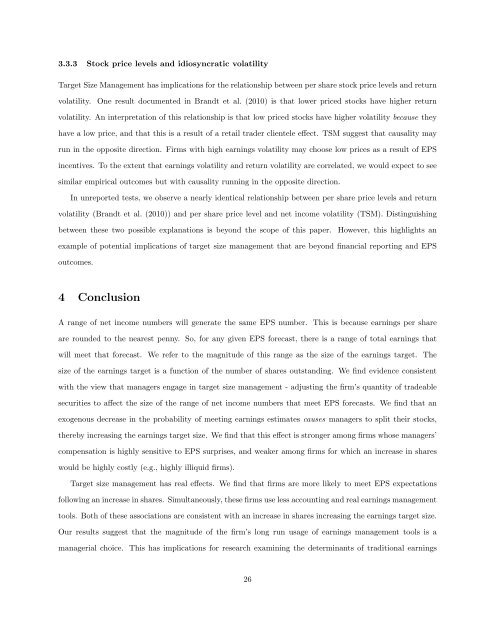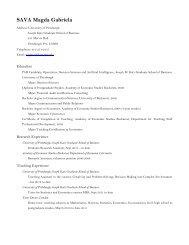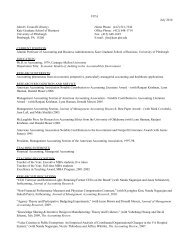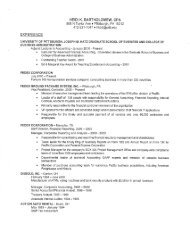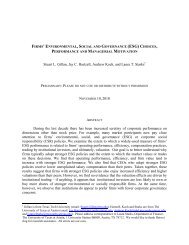Gaming the Float: How Managers Respond to EPS-based Incentives
Gaming the Float: How Managers Respond to EPS-based Incentives
Gaming the Float: How Managers Respond to EPS-based Incentives
Create successful ePaper yourself
Turn your PDF publications into a flip-book with our unique Google optimized e-Paper software.
3.3.3 S<strong>to</strong>ck price levels and idiosyncratic volatility<br />
Target Size Management has implications for <strong>the</strong> relationship between per share s<strong>to</strong>ck price levels and return<br />
volatility. One result documented in Brandt et al. (2010) is that lower priced s<strong>to</strong>cks have higher return<br />
volatility. An interpretation of this relationship is that low priced s<strong>to</strong>cks have higher volatility because <strong>the</strong>y<br />
have a low price, and that this is a result of a retail trader clientele effect. TSM suggest that causality may<br />
run in <strong>the</strong> opposite direction. Firms with high earnings volatility may choose low prices as a result of <strong>EPS</strong><br />
incentives. To <strong>the</strong> extent that earnings volatility and return volatility are correlated, we would expect <strong>to</strong> see<br />
similar empirical outcomes but with causality running in <strong>the</strong> opposite direction.<br />
In unreported tests, we observe a nearly identical relationship between per share price levels and return<br />
volatility (Brandt et al. (2010)) and per share price level and net income volatility (TSM). Distinguishing<br />
between <strong>the</strong>se two possible explanations is beyond <strong>the</strong> scope of this paper.<br />
<strong>How</strong>ever, this highlights an<br />
example of potential implications of target size management that are beyond financial reporting and <strong>EPS</strong><br />
outcomes.<br />
4 Conclusion<br />
A range of net income numbers will generate <strong>the</strong> same <strong>EPS</strong> number. This is because earnings per share<br />
are rounded <strong>to</strong> <strong>the</strong> nearest penny. So, for any given <strong>EPS</strong> forecast, <strong>the</strong>re is a range of <strong>to</strong>tal earnings that<br />
will meet that forecast. We refer <strong>to</strong> <strong>the</strong> magnitude of this range as <strong>the</strong> size of <strong>the</strong> earnings target. The<br />
size of <strong>the</strong> earnings target is a function of <strong>the</strong> number of shares outstanding. We find evidence consistent<br />
with <strong>the</strong> view that managers engage in target size management - adjusting <strong>the</strong> firm’s quantity of tradeable<br />
securities <strong>to</strong> affect <strong>the</strong> size of <strong>the</strong> range of net income numbers that meet <strong>EPS</strong> forecasts. We find that an<br />
exogenous decrease in <strong>the</strong> probability of meeting earnings estimates causes managers <strong>to</strong> split <strong>the</strong>ir s<strong>to</strong>cks,<br />
<strong>the</strong>reby increasing <strong>the</strong> earnings target size. We find that this effect is stronger among firms whose managers’<br />
compensation is highly sensitive <strong>to</strong> <strong>EPS</strong> surprises, and weaker among firms for which an increase in shares<br />
would be highly costly (e.g., highly illiquid firms).<br />
Target size management has real effects. We find that firms are more likely <strong>to</strong> meet <strong>EPS</strong> expectations<br />
following an increase in shares. Simultaneously, <strong>the</strong>se firms use less accounting and real earnings management<br />
<strong>to</strong>ols. Both of <strong>the</strong>se associations are consistent with an increase in shares increasing <strong>the</strong> earnings target size.<br />
Our results suggest that <strong>the</strong> magnitude of <strong>the</strong> firm’s long run usage of earnings management <strong>to</strong>ols is a<br />
managerial choice. This has implications for research examining <strong>the</strong> determinants of traditional earnings<br />
26


